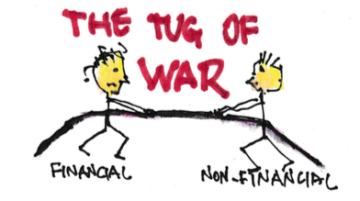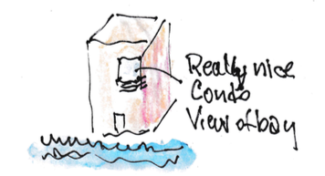What’s the value of the money you have in Non-Financial assets?
Posted on March 1, 2019

I read this book last month, Dollars and Sense: How We Misthink Money …. I liked it. Chapter 2 discusses the concept of Opportunity Cost. “Money equals value equals opportunities.” Every time you spend – or invest – you always have alternate opportunities. You pick one opportunity and forgo at least one other. The one you forgo is your opportunity cost. In a world of only apples and oranges, when you pick the apple you forgo the orange; the orange is your opportunity cost. The point of the book is that we make spending and investing decisions on instinct or emotion. We don’t consider and weigh the alternatives. We don’t think through what we might value most when we decide.
The post discusses this concept in terms of our choices as to what percentage of our total assets we want in financial assets – invested in stocks and bonds – and what percentage we want in non-financial assets – our home and other real estate would be examples.
Many retirees are driven to move more and more of their money into non-financial assets: paying off the mortgage is clearly a goal of many. Have they properly weighed that decision? I think we retirees are far better off with much more of our assets invested in stocks and bonds than into real estate. Patti and I have less than 15% of our total in non-financial assets, and I think that’s about right. (See Chapter 1, Nest Egg Care.)
==== David and his rental condo ====
My friend David at age 68 decided to buy a condo near Bradenton, FL as an investment. What is he doing when he buys the condo? He is shifting money from his financial assets to non-financial assets. He’s trading one opportunity for another.

He told me he hopes to leave $1 million in real estate to his son and daughter. I assume that’s his goal from this condo, not adding his home, a condo nearby. David’s life expectancy is 16 years, so I interpret that is the time horizon that he’d like to have close to $1 million more than he does now. I’ll also assume he thought of those dollars in today’s spending power.
What did he invest? He made a down payment (let’s assume that was $100,000) and he told me that he now has negative cash flow of $4,000 per month or $48,000 per year. (!!!) That’s the net of rental income less his mortgage payment, condo fees, real estate taxes, and utilities.
What was his opportunity cost? The alternative was to leave the money in his investment account. He took money out of that account, selling stocks, for the $100,000. David told me he is continuing to sell stocks and bonds to get the $48,000 per year. He decided to forgo his return on that money in 16 years from his investment account.
What’s that cost? I’ll assume for his mix of stocks and bonds that his expected real return is about 6% per year – that’s assuming typical return rates and a typical sequence of annual returns. Let’s work that out for 16 years. That $100,000 down payment would compound to +$250,000 in today’s spending power. Let’s assume he cuts his cash outlay to $25,000 per year and that continues for 16 years. That compounds to +$640,000 in today’s spending power. The total is $890,000 in today’s spending power.
Now we can state his choice more clearly. He gave up the opportunity to make about $900,000 from his investment portfolio by putting that money in a non-financial asset with the hopes it grows to $1 million. Not much potential difference in my view considering other things he gave up:
• He gave up financial flexibility; in an emergency he can tap his financial assets, but he can’t tap his non-financial assets.
• I think he also bought anxiety. Paying $2,000 a month to something that I get no personal enjoyment from would not make me happy. I think it would drive both Patti and me nuts. We’d constantly be trading that off that $2,000 per month with opportunities for travel – something we really enjoy.
==== Sam and Julie and their HELOC ====
My friend Sam and his wife Julie are almost the exact same age as Patti and I. They have no children or heirs that they want to leave a lot of money to, and their heirs are not expecting anything. Sam told me that his plan is to “run out of money one half hour before we die.” I’d restate that to mean, “We plan to spend as much as we can to enjoy ourselves. We’re not holding back spending to benefit heirs.”
Sam and Julie remodeled their house last year. Sam got a home equity line of credit (HELOC) for $75,000 and pays about $300 per month interest only – about 5% annual interest. They have no other mortgage payment. He thinks his home is worth $450,000. Sam told me he HATES, HATES, HATES writing the check to pay that every month.
I look at that completely differently. I’d actually ENJOY paying $300 per month. I’d look at is this way:
I’d restate the 5% interest on the HELOC to adjust for inflation. Assuming 2% inflation, it’s really 3% real interest rate. It looks like $3,600, but it’s really $2,250 per year.
Lowering their Investment Portfolio by $75,000 translates to lowering their Safe Spending Amount by $3,550 per year. That’s also stated in real terms since it adjusts for inflation each year. (Sam and Julie have the exact same 4.75% Safe Spending Rate [SSR%] as Patti and I. See Chapter 2, Nest Egg Care.) And in all probability that $3,550 will increase in real terms over time. On this basis, Sam’s at least $1,300 ahead each year.
I think Sam should say to himself every time he makes his payment: “I just paid $300 here, but over in my investment account I really just made $100 more than this. That’s going add to $1,000s over time. I think I should look at my investment portfolio and remind myself I have $75,000 more there than I otherwise would have.”
I’d also suggest that Sam look at the $75,000 in his investment portfolio and translate it to something concrete. I’d translate it into how many really great vacations that might be. For Patti and me, $75,000 would easily translate to five trips to Europe. I like that.
====
I don’t like investments in non-financial assets other than our home, which I view as a deep, deep emergency reserve. (See more on this in Chapter 1, Nest Egg Care.) At this stage of life, we want to maximize the financial assets that we can spend and ENJOY NOW.
Conclusion: Every time we decide to spend or invest our money we are always picking one item of value and not another. The one we didn’t pick is our opportunity cost. All of us make spending and investing decisions driven first by emotion, not rational thought. As a result, we can make decisions that simply aren’t in our best interest. Lowering our investments in financial assets to put more – or keep more – in non-financial assets doesn’t make a lot of sense to me at this time of life.